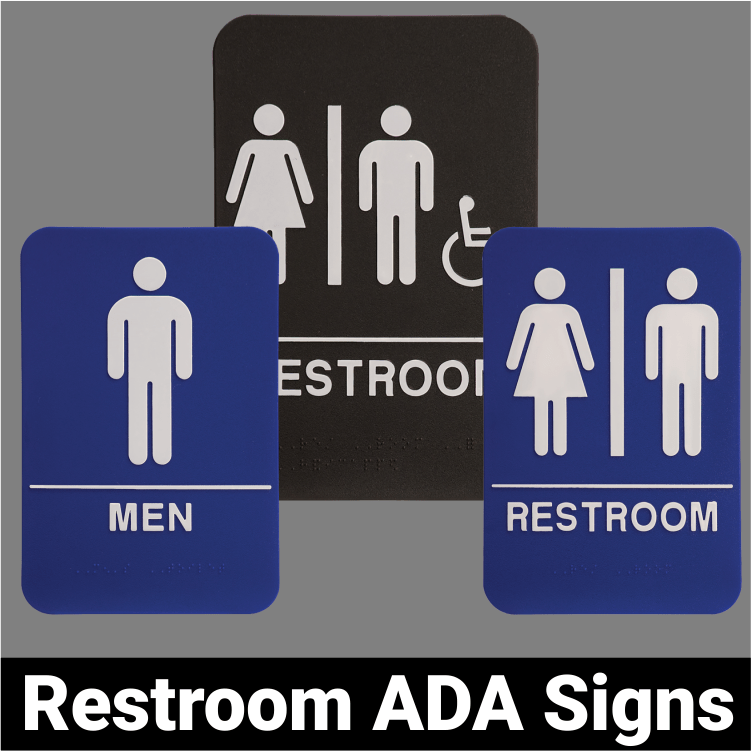Check out the Importance of ADA Signs in Public Spaces
Check out the Importance of ADA Signs in Public Spaces
Blog Article
Checking Out the Trick Features of ADA Indications for Boosted Access
In the world of availability, ADA signs offer as quiet yet effective allies, making sure that areas are accessible and inclusive for people with impairments. By integrating Braille and tactile aspects, these indications break barriers for the aesthetically impaired, while high-contrast shade systems and legible typefaces cater to diverse visual requirements.
Relevance of ADA Conformity
Making certain compliance with the Americans with Disabilities Act (ADA) is important for cultivating inclusivity and equal access in public rooms and workplaces. The ADA, passed in 1990, mandates that all public centers, companies, and transportation solutions accommodate people with disabilities, guaranteeing they take pleasure in the exact same civil liberties and possibilities as others. Conformity with ADA requirements not just satisfies legal obligations however likewise enhances an organization's online reputation by demonstrating its dedication to diversity and inclusivity.
One of the vital elements of ADA compliance is the implementation of available signage. ADA signs are made to make sure that people with handicaps can conveniently navigate with spaces and structures.
Additionally, adhering to ADA guidelines can alleviate the danger of legal consequences and prospective fines. Organizations that stop working to adhere to ADA guidelines might encounter penalties or claims, which can be both harmful and financially challenging to their public picture. Thus, ADA conformity is indispensable to cultivating an equitable setting for everyone.
Braille and Tactile Components
The incorporation of Braille and responsive aspects right into ADA signage personifies the principles of accessibility and inclusivity. These features are crucial for individuals that are blind or aesthetically impaired, enabling them to browse public rooms with higher freedom and confidence. Braille, a responsive writing system, is essential in supplying composed details in a style that can be easily viewed with touch. It is usually positioned below the matching message on signage to make certain that individuals can access the info without aesthetic aid.
Tactile aspects prolong beyond Braille and consist of increased signs and characters. These elements are designed to be noticeable by touch, permitting people to identify area numbers, toilets, exits, and other vital areas. The ADA sets specific guidelines relating to the dimension, spacing, and placement of these tactile components to maximize readability and ensure consistency throughout various environments.

High-Contrast Color Pattern
High-contrast color design play a pivotal duty in improving the visibility and readability of ADA signs for individuals with aesthetic impairments. These plans are crucial as they make the most of the difference in light reflectance between message and history, ensuring that indicators are conveniently noticeable, even from a distance. The Americans with Disabilities Act (ADA) mandates making use of certain shade contrasts to suit those with minimal vision, making it a critical aspect of conformity.
The efficacy of high-contrast colors exists in their capability to stand out in numerous lights conditions, including dimly lit atmospheres and locations with glare. Generally, dark text on a light background important source or light text on a dark background is utilized to attain optimum comparison. Black message on a white or yellow history supplies a stark aesthetic distinction that assists in fast acknowledgment and comprehension.

Legible Fonts and Text Dimension
When taking into consideration the design of ADA signage, the option of understandable fonts and ideal text dimension can not be overstated. The Americans with Disabilities Act (ADA) mandates that fonts must be sans-serif and not italic, oblique, manuscript, extremely decorative, or of unusual form.
The size of the message likewise plays a pivotal function in access. According to ADA standards, the minimal message elevation should be 5/8 he has a good point inch, and it needs to enhance proportionally with checking out distance. This is especially crucial in public rooms where signage demands to be read swiftly and accurately. Uniformity in text dimension adds to a natural visual experience, helping individuals in browsing settings successfully.
Moreover, spacing in between letters and lines is important to clarity. Sufficient spacing prevents personalities from appearing crowded, enhancing readability. By adhering to these standards, developers can substantially boost accessibility, guaranteeing that signage serves its desired function for all individuals, no Website matter their visual capacities.
Effective Positioning Approaches
Strategic placement of ADA signs is necessary for making the most of access and guaranteeing compliance with legal requirements. ADA guidelines stipulate that signs must be mounted at an elevation between 48 to 60 inches from the ground to guarantee they are within the line of view for both standing and seated people.
In addition, indications need to be positioned surrounding to the lock side of doors to allow easy recognition prior to access. Uniformity in indication placement throughout a center enhances predictability, decreasing complication and boosting general customer experience.

Final Thought
ADA signs play a vital role in promoting accessibility by incorporating functions that attend to the requirements of people with disabilities. These elements jointly promote a comprehensive environment, underscoring the relevance of ADA conformity in making certain equal access for all.
In the realm of access, ADA indications offer as quiet yet effective allies, making certain that rooms are navigable and inclusive for people with specials needs. The ADA, enacted in 1990, mandates that all public centers, employers, and transport solutions accommodate people with impairments, guaranteeing they delight in the same civil liberties and possibilities as others. ADA Signs. ADA indications are developed to ensure that people with specials needs can easily browse with areas and buildings. ADA standards specify that indications should be placed at a height in between 48 to 60 inches from the ground to ensure they are within the line of view for both standing and seated individuals.ADA indicators play a crucial function in advertising availability by integrating features that address the requirements of individuals with specials needs
Report this page